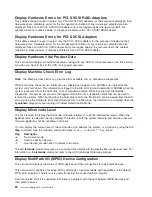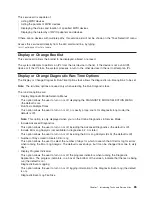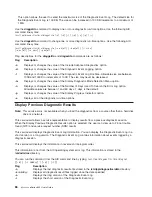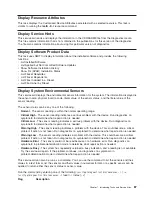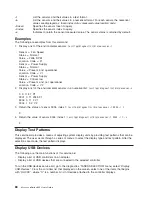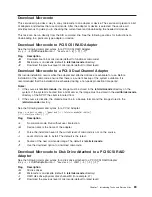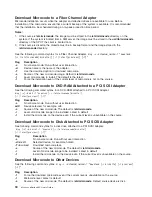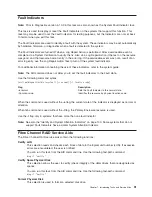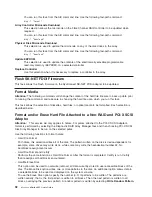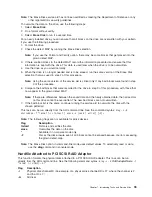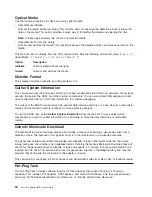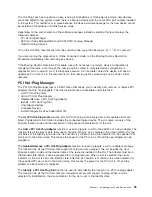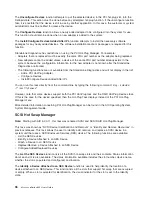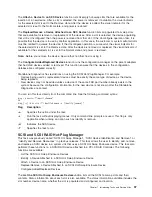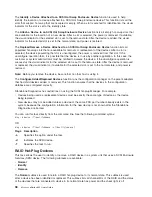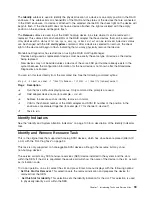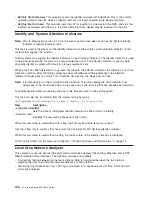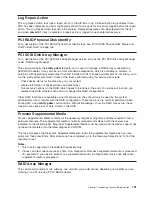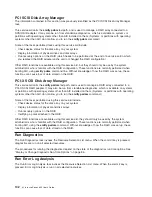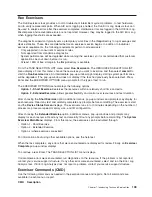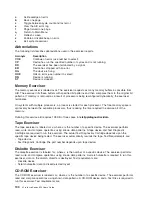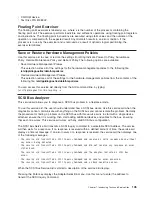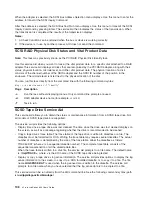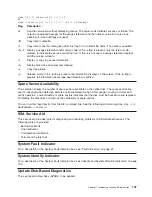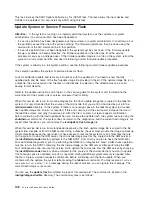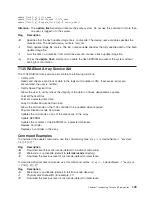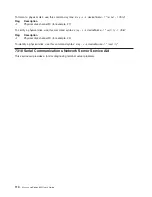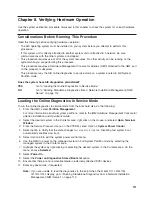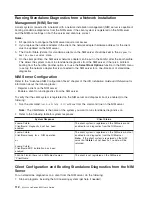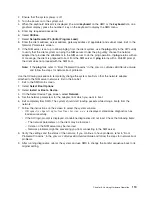
The
Identify
a
Device
Attached
to
an
SCSI
Hot
Swap
Enclosure
Device
function
is
used
to
help
identify
the
location
of
a
device
attached
to
a
SCSI
Hot
Swap
Enclosure
device.
This
function
lists
all
the
slots
that
support
hot
swap
that
are
occupied
or
empty.
When
a
slot
is
sele
ted
for
identification,
the
visual
indicator
for
the
slot
is
set
to
the
identify
state.
The
Attach
a
Device
to
an
SCSI
Hot
Swap
Enclosure
Device
function
lists
all
empty
hot-swap
slots
that
are
available
for
the
insertion
of
a
new
device.
After
a
slot
is
selected,
the
power
is
removed.
If
available,
the
visual
indicator
for
the
selected
slot
is
set
to
the
remove
state.
After
the
device
is
added,
the
visual
indicator
for
the
selected
slot
is
set
to
the
normal
state,
and
power
is
restored.
The
Replace/Remove
a
Device
Attached
to
an
SCSI
Hot
Swap
Enclosure
Device
function
lists
all
populated
hot-swap
slots
that
are
available
for
removal
or
replacement
of
the
devices.
After
a
slot
is
selected,
the
device
populating
that
slot
is
unconfigured,
the
power
is
removed
from
that
slot.
If
the
unconfigure
operation
fails,
it
is
possible
that
the
device
is
in
use
by
another
application.
In
this
case,
the
customer
or
system
administrator
must
be
notified
to
quiesce
the
device.
If
the
unconfigure
operation
is
successful,
the
visual
indicator
for
the
selected
slot
is
set
to
the
remove
state.
After
the
device
is
removed
or
replaced,
the
visual
indicator,
if
available
for
the
selected
slot,
is
set
to
the
normal
state,
and
power
is
restored.
Note:
Before
you
remove
the
device,
be
sure
that
no
other
host
is
using
it.
The
Configure
Added/Replaced
Devices
function
runs
the
configuration
manager
on
the
parent
adapters
that
had
child
devices
added
or
removed.
This
function
ensures
that
the
devices
in
the
configuration
database
are
configured
correctly.
Standalone
Diagnostics
has
restrictions
on
using
the
SCSI
hot-plug
Manager.
For
example:
v
Devices
being
used
as
replacement
devices
must
be
exactly
the
same
type
of
device
as
the
device
being
replaced
v
New
devices
may
not
be
added
unless
a
device
of
the
same
FRU
part
number
already
exists
in
the
system,
because
the
configuration
information
for
the
new
device
is
not
known
after
the
Standalone
Diagnostics
are
booted.
You
can
run
this
task
directly
from
the
command
line.
See
the
following
command
syntax:
diag
-d
device
-T"identifyRemove
OR
diag
-d
device
-T"identifyRemove
-a
[identify|remove
]
Flags
Description
-a
Specifies
the
option
under
the
task.
-d
Indicates
the
SCSI
device.
-T
Specifies
the
task
to
run.
RAID
Hot-Plug
Devices
This
task
allows
the
user
to
identify,
or
remove
a
RAID
device
in
a
system
unit
that
uses
a
SCSI
Enclosure
Services
(SES)
device.
The
following
subtasks
are
available:
v
Normal
v
Identify
v
Remove
The
Normal
subtask
is
used
to
return
a
RAID
hot-plug
device
to
its
normal
state.
This
subtask
is
used
after
a
device
has
been
identified
or
replaced.
This
subtask
lists
all
channel/IDs
of
the
RAID
and
the
status
of
the
devices
that
are
connected.
A
device
in
its
normal
state
has
power
and
the
check
light
is
off.
98
Eserver
pSeries
655
User’s
Guide
Summary of Contents for p 655 series
Page 1: ...pSeries 655 User s Guide SA38 0617 03 ERserver...
Page 2: ......
Page 3: ...pSeries 655 User s Guide SA38 0617 03 ERserver...
Page 10: ...viii Eserver pSeries 655 User s Guide...
Page 14: ...xii Eserver pSeries 655 User s Guide...
Page 16: ...xiv Eserver pSeries 655 User s Guide...
Page 24: ...6 Eserver pSeries 655 User s Guide...
Page 32: ...14 Eserver pSeries 655 User s Guide...
Page 36: ...18 Eserver pSeries 655 User s Guide...
Page 90: ...72 Eserver pSeries 655 User s Guide...
Page 144: ...126 Eserver pSeries 655 User s Guide...
Page 208: ...190 Eserver pSeries 655 User s Guide...
Page 214: ...196 Eserver pSeries 655 User s Guide...
Page 217: ......

